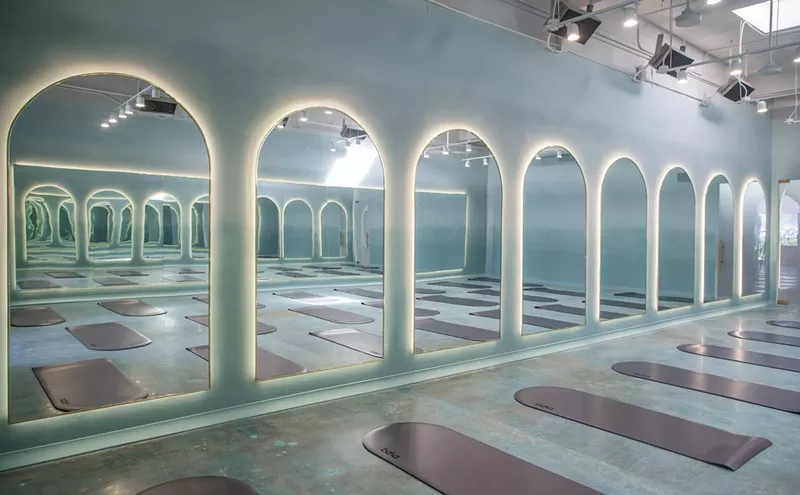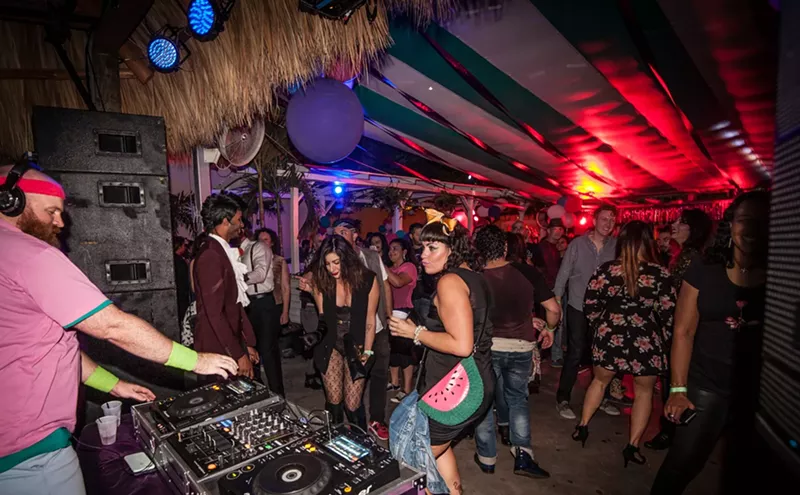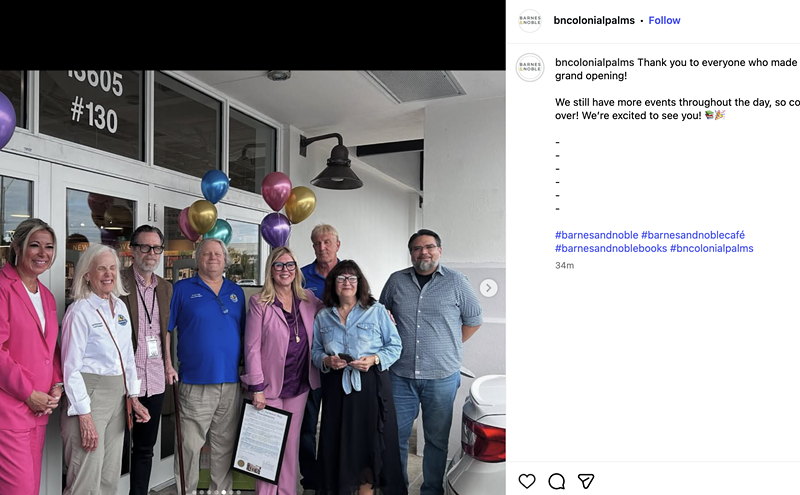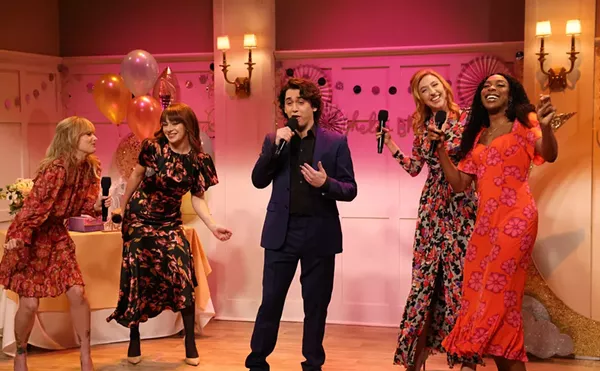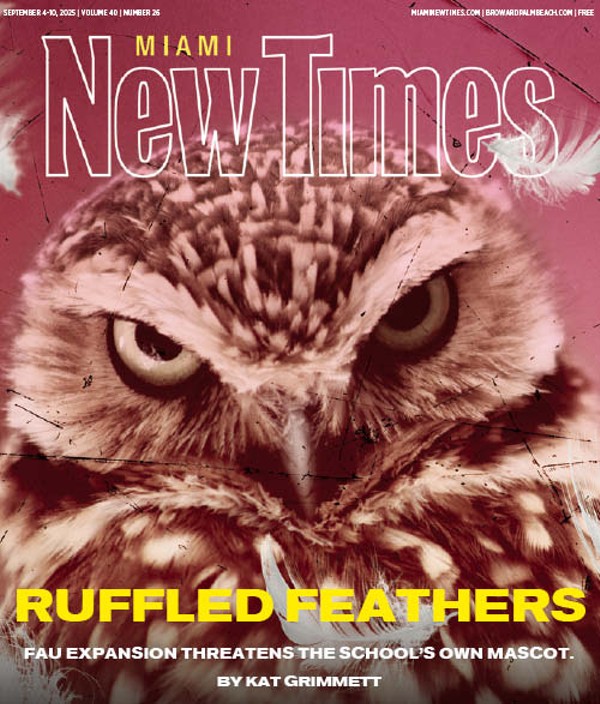A quote attributed to Christo and Jeanne-Claude at the entrance of the show expresses it rather eloquently: "Any element of impermanence in an artwork creates a feeling of fragility, even vulnerability, as well as a sense of urgency about viewing it. There is at the same time an inherent awareness of the loss we feel at its absence, knowing that tomorrow it will be gone." You need to be there to absorb the "eternity of the moment," as German art critic Petra Kipphoff put it, before it vanishes forever.
For those of us who have not had the opportunity to see these works in their actual context, this exhibit is the next best thing. It displays compelling documentation of the technical requirements and processes that eventually led to the completion of some of their more ambitious projects. (In 1983 many Miamians had the unique experience of actually participating in the creation of one of those projects, Surrounded Islands, in which eleven spoil islands in Biscayne Bay were encircled by vivid pink fabric.)
Bulgarian-born Christo Vladimirov Javacheff and his French wife, Jeanne-Claude Denat de Guillebon, have always declined sponsorship, patronage, and commercial subsidy, and have funded their projects themselves from the sale of their preliminary work -- the materials on view at this show. The Würth collection includes illustrations of most of the artists' oeuvre, from the earliest to their most recent, The Gates, a dynamic installation of 7500 saffron-colored fabric panels suspended from frames ("gates") that snaked through the pathways in New York's Central Park. (The Gates was unveiled this past February 12 and remained up beyond its originally scheduled sixteen-day run due to immense popularity.)
The Würth collection also includes actual pieces, such as 1963's Wrapped Road Sign, two triangular traffic signs covered with rope and fabric; and an example of the artists' Store Fronts series: architectural sculptures, created between 1964 and 1967, in which life-size glass windows are partly concealed by a cloth, thwarting the viewer from seeing what's within, unlike commercial façades bent on inviting us to look inside.
But Christo and Jeanne-Claude later became known for much grander undertakings, relentless but still gentle and conscientious incursions upon the world's landscapes and urban edifices. After a scrupulously documented process of preparatory sketches, drawings, collages, scale models, and countless hours in negotiation with governmental agencies over public safety and environmental issues, the team launches colossal "wrapping" ventures: the Pont Neuf bridge in Paris (covered for two weeks in 1985), the Reichstag in Berlin (two weeks in 1995), the Little Bay coast in Australia (seven weeks in 1969), and Wrapped Trees, 178 trees wrapped in nearly 600,000 square feet of translucent fabric (Riehen, Switzerland, two weeks in 1998).
The collection of illustrations confirms Christo's prowess as a draftsman, and many collages incorporate mixed media, such as topographical maps, floor plans, vibrant drawings, photos, and actual materials from the installation. Some of the photographs and a large-scale model in the exhibition's display of the Wrapped Reichstag give a hint of what it might have been like to be there. But these initial works consist mostly of eye candy for curious viewers.
Christo and Jeanne-Claude are not conceptual artists; they aim to materialize each idea on paper and in scale-model form and then give us the chance to see familiar objects in a completely novel way: as works of art. The duo is pushing for a new project called Over the River -- fabric panels draped above the waters of the Arkansas River in Colorado. According to their Website (www.christojeanneclaude.net), which contains drawings of the proposed project, progress is slow: "Specific dates are not yet possible. The permits for the project have not been awarded. This process can take many, many years. The Gates took 26 years for permits and permissions."
Go see the Bass show, but keep an eye out for Over the River. It just might be worth a summertime road trip.
Compared to Christo and Jeanne-Claude's mammoth projects, Joe Fig's miniature constructions of artists' studios are quite intimate. His exhibit "The Artist's Studio" encourages voyeurism as viewers are invited to peek inside the cloistered areas where artists struggle with creativity in isolation, a kind of sacred atelier immune to the outside art world.
Fig still manages to respect his real-life subjects by crafting delicate and tremendously detailed compositions that don't necessarily infringe on the artists' privacy. Rather they celebrate their talent and the setting in which they create most of their work. He isn't making these pieces for the sake of gratuitously revealing the personal quarters of esteemed contemporary artists. Instead these works can be seen as homages to the individual artists. At the same time, though, the tiny studios are intriguing aesthetic structures that can give viewers an idea of how well-known artists organize their work areas.
Glance into the studio of painter Chuck Close, which, like Close's work, is realistic down to the smallest detail (there are even specific art magazines scattered across his desk). In Jackson Pollock's Long Island sanctum we see the artist pondering one of his action paintings, laid out on the floor. Also of interest are Fig's photographs of the interiors of his ministudios. Shot from various angles, Fig's photos bring a particular viewpoint to his sculptures, allowing the viewer to see them in a different light. Most notable is the 1951 studio of Abstract Expressionist Barnett Newman, The Sublime Is Now! Sunlight beams into the room as Newman, cigarette in hand, intensely examines one of his "zip" paintings.



